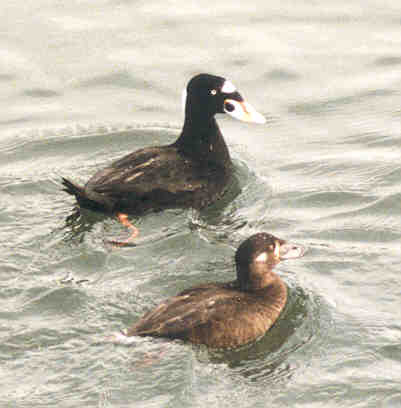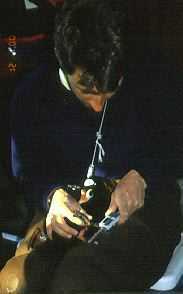(Melanitta perspicillata)
 Current
Status
Current
Status
Nearly
all North American seaduck species are exhibiting continental population
declines and there is a fear that this trend could be indicative of widespread
environmental degradation (Goudie et al. 1994). The ecological causes for
declining seaduck population trends is poorly understood; though habitat
destruction, pollution, excessive hunting, and climate change may all play
important roles.In recent years,
increasing attention has focused on surf scoters (Melanitta perspicillata)
as a potential model species for understanding seaduck population declines
and assessing the condition of the nearshore coastal ecosystems.
Surf scoters are a stout diving duck belonging to the tribe Mergini (Bellrose 1980).They are endemic to North America, dividing their time between isolated breeding sites in northern Canada and Alaska and coastal marine habitats where they are a common sight near many major population centers on both the Atlantic and Pacific coasts (Savard 1998).Surf scoters have a global rarity rank of G5, indicating that North American populations are widespread, abundant, and secure.However, the British Columbia Ministry of Environment, Land and Parks (BC Conservation Data Centre 2000) has designated them as a ăBlue Listä species.Blue List taxa are of special concern because of characteristics that make them particularly sensitive to disturbance from human activities or natural events. Blue-listed taxa are at risk, but are not extirpated, endangered or threatened (Master 1991).
Surf
Scoters are being studied by CWE researcher Sam
Iverson.
 Photo:
Sam measuring a Surf Scoter
Photo:
Sam measuring a Surf Scoter
Description
and Systematics
Members
of the seaduck clade share several life-history and ecological characters,
including diving habit and primary reliance on animal prey, moderately
heavy wing-loading and rapid flight, age of sexual maturity of two or more
years, and predominately diurnal activity patterns (Livezey 1995).Of
the three species that comprise the Melanitta genus, surf scoters
are most closely related to white-winged scoters (Livezey 1995).
Adult
male surf scoters are black, with conspicuous white patches on the forehead
and nape, distinguishing multicolored bills, white eyes, and orange legs
and feet.Females are uniformly brown,
sometimes exhibiting white patches on the cheeks below the eye and a variably
distinct nape patch (Palmer 1976; Bellrose 1980). No geographic variation
in the appearance or morphology of surf scoters has been reported (Palmer
1976), and the extent of genetic differentiation of subpopulations has
not been studied (Savard 1998).
Distribution, Migration, & Habitat
Surf
scoters are considered a complete medium distance migrant. On the Atlantic
Coast a large proportion of the population stages in the St. Lawrence estuary
and gulf in the spring (Falardeau et al. 1998).On
the Pacific coast, spring herring spawns seem to be a critical food source
for migrating birds (Haegele 1993; Vermeer et al. 1997).Breeding
habitat in the northern boreal regions of Canada and Alaska is characterized
by shallow, clear, oxygen-saturated lakes surrounded by scrub forest (Bergeron
et al.1996; Savard & Lamothe 1991).Molt
migration is well developed, with breeders flying extensive distances from
breeding grounds to remote coastal sites (Rosenberg unpublished data).Molting
site selection and the energetics of wing molt are likely a critical component
of survival in migratory birds (Holmgren & Hedenstrom 1995.)
The dynamics and mortality associated with fall migration are also poorly understood due in part to the staggered timing at which males, immatures, and females depart from molt sites (Savard 1998).Winter populations stabilize by December and extend from the Aleutian Islands to Baja California on the Pacific coast and from Newfoundland to Florida on the Atlantic coast (AOU 1998).For most of the year surf scoters frequent shallow marine waters and are most abundant over sand-mud, cobble, and rocky substrates (Goudie et al. 1994).Along the rocky shores of the Canadian Pacific, a vast majority occur within one kilometer of land (Vermeer 1981).
Literature
Cited
American
Ornithologists' Union(1998) Checklist
of North American Birds.7th edition.
B.C.
Conservation Data Centre (2000) Wildlife Inventory Section, Resources Inventory
Branch, Ministry of Environment, Lands and Parks Victoria, BC.
Bergeron,
R.R., Hughes, J., & Reed, A. (1996) Projet de Laforge-1. Etude de la
sauvagine et caracterisation de ses habitats÷ete 1995.Final
Report, Direction Ingenierie et Environment, Societe dâ energie de la Baie
James and Groupe Dryade
Ltee, QC.
Falardeau,
G., Savard, J.-P.L., & Dupuis P. (1998) Migration printaniere des macreuses
Goudie,
R.I., Brault, S., Conant, B. A.V. Kondratyev, Petersen, M.R., & Vermeer,
K. (1994) The status
of sea ducks in the north Pacific rim: toward their conservation and management.Trans.
59th N. Am. Wild. Nat. Resour. Conf.: 27-49.
Haegele,
C.W. (1993) Seabird predation of Pacific Herring, Clupea pallasi, spawn
in
Holmgren, N. & Hedenstrom, A. (1995) The scheduling of molt in migratory birds.Evolutionary Ecology 9(4): 354-368
Livezey, B.C. (1995) Phylogeny and evolutionary ecology of modern seaducks (Anatidae: Mergini). Condor 97: 233-255.
Master,
L.L. 1991. Assessing threats and setting priorities for conservation.
Conservation
Palmer,
R.S. (1976) Handbook of North American birds.Vol.
3. Yale University Press,
Savard,
J.-P.L. & Lamothe, P. (1991) Distribution, abundance, and aspects of
breeding
ecology of Black Scoters, Melanitta nigra, and Surf Scoters, Melanitta perspicillata, in northern Quebec. Can. Field-Nat. 105: 488-496.
Savard,
J.-P.L. (1989) Birds of the rocky coastline and pelagic waters in the strait
of
Veermeer,
K., M. Bentley, K.H. Morgan, and G.E.J. Smith in Vermeer, K. and K.H.
Vermeer,
K. (1981) Food and populations of Surf Scoters in British Columbia.Wildfowl
